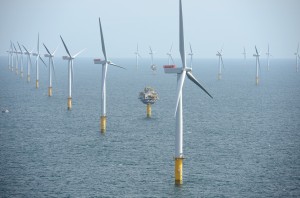
The Sheringham Shoal Wind Farm
Setting aside the current Government’s shift in attitude towards renewable energy the UK has, to date, led the world in creating a commercially successful offshore wind industry. Over 5 gigawatts (GW) of operational windfarms within UK waters currently provide enough electricity for over 3 and a half million homes annually, and a further 14.3GW has been approved for construction, all of which has been developed since 2000. Much of this capacity sits in the English Channel and southern North Sea making it, geographically at least, as European as it is possible for British infrastructure to be.
Approval for UK offshore windfarms is provided by UK law (location dependent – Scottish law in Scotland, English and Welsh law in England and Wales). The consenting regime for offshore wind is driven by European Directives such as the Strategic Environmental Assessment (SEA), Environmental Impact Assessment (EIA), Habitats and Birds Directives, regardless of which EU country the project is located in.
This requires that each member nation must adhere to a standard of assessment appropriate for the scale of a development. This is an excellent example of non-economic benefits arising from the EU, or more specifically, benefits whose primary purpose is not economic.
The potential impact on populations of mobile or migratory species such as birds and marine mammals (who do not acknowledge international boundaries) is a major consideration in establishing the location of offshore windfarms at a strategic level, and is considered in detail as part of the consent application for each individual project. It would therefore be absurd for the UK to undertake work in this field were it to be ignored by our European counterparts (or vice versa). Migratory birds, by definition, cannot be attributed to, or cared for by, a single country. The same applies to marine mammals; to fish; and in a similar way the shipping and fishing industries must be considered. Without this cohesive network of assessment and consideration, it would be impossible to afford protection to populations of species – something that would benefit neither biodiversity nor industry.
Environmental regulation is often dismissed by naysayers as ‘red tape’, and countless examples are available of seemingly expensive mitigation measures for Great Crested Newts, or for the relocation of badgers to make way for a particular development. But the alternative to this is that development is allowed to ride roughshod over the existing environment, and the unknown consequences of this are such that, inevitably, populations of sensitive species will become irrevocably damaged.
Countries outside of the EU but within its geographic region (e.g. Norway) tend to follow the protocols established within European Directives, thereby allowing access to the single market. It would be reasonable to assume the UK would do the same following a Brexit however, like Norway, we would then have no ability to influence these Directives.
The standard of Environmental Impact Assessment within the UK is excellent, and this combined with our position in the EU affords us the ability to influence policy and improve standards across the board. Being excellent in isolation is pointless.
Richard Campbell is an expert in the renewable energy sector.
9th March 2016
